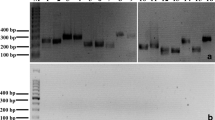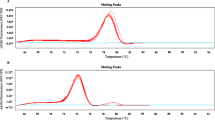Abstract
Quantitative PCR (qPCR) assays targeting the host-specific Bacteroides-Prevotella 16S rRNA genetic markers have been proposed as one of the promising approaches to identify the source of fecal contamination in environmental waters. One of the concerns of qPCR assays to environmental samples is the reliability of quantified values, since DNA extraction followed by qPCR assays are usually performed without appropriate sample process control (SPC) and internal amplification controls (IACs). To check the errors in sample processing and improve the reliability of qPCR results, it is essential to evaluate the DNA recovery efficiency and PCR amplification efficiency of the target genetic markers and correct the measurement results. In this study, we constructed a genetically-engineered Escherichia coli K12 strain (designated as strain MG1655 Δlac::kan) as sample process control and evaluated the applicability to environmental water samples. The recovery efficiency of the SPC strain MG1655 Δlac::kan was similar to that of Bacteroides fragilis JCM 11019, when DNA were extracted from water samples spiked with the two bacteria. Furthermore, the SPC was included in the qPCR assays with propidium monoazide (PMA) treatment, which can exclude the genetic markers from dead cells. No significant DNA loss was observed in the PMA treatment. The inclusion of both the SPC (strain MG1655 Δlac::kan) and IAC in qPCR assays with PMA treatment gave the assurance of reliable results of host-specific Bacteroides-Prevotella 16S rRNA genetic markers in environmental water samples.





Similar content being viewed by others
References
APHA, AWWA, WEF (2005) Standard method for the examination of water and wastewater, 21st edn. American Public Health Association, Washington D.C
Bae S, Wuertz S (2009) Discrimination of viable and dead fecal Bacteroidales bacteria by quantitative PCR with propidium monoazide. Appl Environ Microbiol 75:2940–2944
Blattner FR, Plunkett G, Bloch CA, Perna NT, Burland V, Riley M, Collado-Vides J, Glasner JD, Rode CK, Mayhew GF, Gregor J, Davis NW, Kirkpatrick HA, Goeden MA, Rose DJ, Mau B, Shao Y (1997) The complete genome sequence of Escherichia coli K-12. Science 277:1453–1462
Cho J-C, Kim S-J (2000) Increase in bacterial community diversity in subsurface aquifers receiving livestock wastewater input. Appl Environ Microbiol 66:956–965
D’Agostino M, Cook N, Rodriguez-Lazaro D, Rutjes S (2011) Nucleic acid amplification-based methods for detection of enteric viruses: definition of controls and interpretation of results. Food Environ Virol 2:55–60
Diez-Valcarce M, Cook N, Hernandez M, Rodriguez-Lazaro D (2011) Analytical application of a sample process control in detection of foodborne viruses. Food Anal Methods 4:614–618
Datsenko KA, Wanner BL (2000) One-step inactivation of chromosomal genes in Escherichia coli K-12 using PCR products. Proc Natl Acad Sci U S A 97:6640–6645
Field KG, Bernhard AE, Brodeur TJ (2003) Molecular approaches to microbiological monitoring: fecal source detection. Environ Monit Assess 81:313–326
Field KG, Samadpour M (2007) Fecal source tracking, the indicator paradigm, and managing water quality. Water Res 41:3517–3538
Fremaux B, Boa T, Yost CK (2010) Quantitative real-time PCR assays for sensitive detection of Canada goose-specific fecal pollution in water sources. Appl Environ Microbiol 76:4886–4889
Green HC, Field KG (2012) Sensitive detection of sample interference in environmental qPCR. Water Res 46:3251–3260
Harwood VJ, Brownell M, Wang S, Lepo J, Ellender RD, Ajidahun A, Hellein KN, Kennedy E, Ye X, Flood C (2009) Validation and field testing of library-dependent microbial source tracking methods in the Gulf of Mexico. Water Res 43(19):4812–4819
Haugland RA, Varma M, Sivaganesan M, Kelty C, Peed L, Shanks OC (2010) Evaluation of genetic markers from the 16S rRNA gene V2 region for use in quantitative detection of selected Bacteroidales sp. and human fecal waste by qPCR. Syst Appl Microbiol 33(6):348–357
Ishii S, Segawa T, Okabe S (2013) Simultaneous quantification of multiple food and waterborne pathogens by use of microfluidic quantitative PCR. Appl Environ Microbiol 79:2891–2898
Kassa H, Harrington B, Bisesi MS (2001) Risk of occupational exposure to Cryptosporidium, Giardia, and Campylobacter associated with the feces of giant Canada geese. Appl Occup Environ Hyg 16(9):905–909
Kildare BJ, Leutenegger CM, McSwain BS, Bambic DG, Rajal VB, Wuertz S (2007) 16S rRNA-based assays for quantitative detection of universal, human-, cow-, and dog-specific fecal Bacteroidales, a Bayesian approach. Water Res 41:3701–3715
Klappenbach JA, Saxman PR, Cole JR, Schmidt TM (2000) rrndb: the ribosomal RNA operon copy number database. Nucleic Acids Res 29:181–184
Kobashi Y, Hasebe A, Nishio M (2005) Antibiotic-resistant bacteria from feces of livestock, farmyard manure, and farmland in Japan—Case report. Microbes Environ 20(1):53–60
Kobayashi A, Sano D, Hatori J, Ishii S, Okabe S (2013) Chicken- and duck-associated Bacteroides-Prevotella genetic markers for detecting fecal contamination in environmental water. Appl Microbiol Biotechnol 97:7427–7437
Meays CL, Broersma K, Nordin R, Mazumder A (2004) Source tracking fecal bacteria in water: a critical review of current method. J Environ Manag 73:71–79
Mieszkin S, Furet JP, Corthier G, Gourmelon M (2009a) Estimation of pig fecal contamination in a river catchment by real-time PCR using two pig-specific Bacteroidales 16S rRNA genetic markers. Appl Environ Microbiol 75:3045–3054
Mieszkin S, Yala J-F, Joubrel R, Gourmelon M (2009b) Phylogenetic analysis of Bacteroidales 16S rRNA gene sequences from human and animal effluents and assessment of ruminant fecal pollution by real-time PCR. J Appl Microbiol 108:974–984
Nielsen KM, Johnsen PJ, Bensasson D, Daffonchio D (2007) Release and persistence of extracellular DNA in the environment. Environ Biosafety Res 6(1–2):37–53
Nocker A, Cheung CY, Camper AK (2006) Comparison of propidium monoazide with ethidium monoazide for differentiation of live versus dead bacteria by selective removal of DNA from dead cells. J Microbiol Methods 67(2):310–320
Okabe S, Okayama N, Savichtcheva O, Ito T (2007) Quantification of host-specific Bacteroides-Prevotella 16S rRNA genetic markers for assessment of fecal pollution in freshwater. Appl Microbiol Biotechnol 74:890–901
Okabe S, Shimazu Y (2007) Persistence of host-specific Bacteroides-Prevotella 16S rRNA genetic markers in environmental waters: effects of temperature and salinity. Appl Microbiol Biotechnol 76:935–944
Sambrook J, Fritsch EF, Maniatis T (1989) Molecular Cloning: A Laboratory. Manual, 2nd edn. Cold Spring Harbor Laboratory, Cold Spring Harbor
Savichtcheva O, Okabe S (2006) Alternative indicators of fecal pollution: relations with pathogens and conventional indicators, current methodologies for direct pathogen monitoring, and future application perspectives. Water Res 40:2463–2476
Savichtcheva O, Okayama N, Okabe S (2007) Relationships between Bacteroides 16S rRNA genetic markers and presence of bacterial enteric pathogens and conventional fecal indicators. Water Res 41:3615–3628
Scott TM, Rose JB, Jenkins TM, Farrah SR, Lukasik J (2002) Microbial source tracking: current methodology and future directions. Appl Environ Microbiol 68:5796–5803
Seurinck S, Defoirdt T, Verstraete W, Siciliano SD (2005) Detection and quantification of the human-specific HF183 Bacteroides 16S rRNA genetic marker with real-time PCR for assessment of human fecal pollution in freshwater. Environ Microbiol 7:249–259
Shanks OC, Kelty CA, Sivaganesan M, Varma M, Haugland RA (2009) Quantitative PCR for genetic markers of human fecal pollution. Appl Environ Microbiol 75:5507–5513
Simpson JM, Santo Domingo JW, Reaspner DJ (2002) Microbial source tracking: state of the science. Environ Sci Technol 24:5279–5288
Smalla K, van Overbeek LS, Pukall R, van Elsas JD (1993) Prevalence of nptII and Tn5 in kanamycin-resistant bacteria from different environments. FEMS Microbiol Ecol 13:47–58
Stewart JR, Ellender RD, Gooch JA, Jiang S, Myoda SP, Weisberg SB (2003) Recommendations for microbial source tracking: lessons from a methods comparison study. J Water Health 1(4):225–231
Stoeckel DM, Stelzer EA, Dick LK (2009) Evaluation of two spike-and-recovery controls for assessment of extraction efficiency in microbial source tracking studies. Water Res 43:4820–4827
Taskin B, Gozen AG, Duran M (2011) Selective quantification of viable Escherichia coli in biosolids by quantitative PCR with propidium monoazide. Appl Environ Microbiol 77:4329–4335
Varma M, Field R, Stinson M, Rukovets B, Wymer L, Haugland R (2009) Quantitative real-time PCR analysis of total and propidium monoazide-resistant fecal indicator bacteria in wastewater. Water Res 43:4790–4801
Yanisch-Perron C, Vieira J, Messing J (1985) Improved M13 phage cloning vectors and host strains: nucleotide sequences of the M13mp18 and pUC19 vectors. Gene 33:103–119
Acknowledgments
This work was funded by Core Research for Evolutionary Science and Technology (CREST) from Japan Science and Technology Agency (JST) and grant-in-aid for Scientific Research A (23246094) from Japan Society for the Promotion of Science (JSPS).
Author information
Authors and Affiliations
Corresponding author
Electronic supplementary material
Below is the link to the electronic supplementary material.
ESM 1
(PDF 151 kb)
Rights and permissions
About this article
Cite this article
Kobayashi, A., Sano, D., Taniuchi, A. et al. Use of a genetically-engineered Escherichia coli strain as a sample process control for quantification of the host-specific bacterial genetic markers. Appl Microbiol Biotechnol 97, 9165–9173 (2013). https://doi.org/10.1007/s00253-013-5188-z
Received:
Revised:
Accepted:
Published:
Issue Date:
DOI: https://doi.org/10.1007/s00253-013-5188-z




